Summary
10 trees with white flowers include the following:
- Magnolia trees
- Elder trees
- Rowan trees
- Japanese snowbell trees
- Apple trees
- Fringe trees
- Catalpa trees
- Silverbell trees
- White oleander trees
- White crape myrtle trees
Each has its own care requirements and considerations.
Trees With White Flowers
There is something almost otherworldly about a white flowering tree in full bloom.
No matter who you are or what your level of interest in plants is, such a tree draws your attention and requires a pause to take in its beauty.
If you’re anything like me, your memory is dotted with all manner of plants and places:
- The first time I saw a magnolia in bloom
- The 60-year-old ornamental apple in the backyard of my first house that was, for one day a year, the most beautiful thing in the vicinity
- A spring orchard walk through some blossoming pears at my local cidery
- A visit to the downtown park to see the long-standing cherry blossoms
- The Japanese lilac on the north side of my house that reliably stays in bloom a week longer than the rest
- The bunched sprays of flowers of rowan or elder, buzzing in the sunshine with bees, stunning us now and reminding us of their future fruit, of the shape of things to come
You get the idea and probably have some memories like this yourself.
We mentally catalog these plants, where they live in our cities and neighborhoods, and form relationships with them.
They become touchpoints throughout the year, reminding us where we are in the season. They can be something to look forward to as winter becomes long and things seem kind of dreary.
We seek these plants out again and again, plan to stroll by them or stop for a quiet moment under their canopies each year, timing our visits to hopefully catch them at peak resplendence (it is often quite fleeting), to marvel. They’re just that beautiful.
Whether you’re looking to incorporate this kind of effect into your garden or haven’t considered how striking white blooms can be, here are 10 of my most recommended trees with white flowers.
A Note On Hardiness Zones
Use hardiness zone recommendations as a suggested guideline. If gardeners were to solely follow these recommendations, many of the gardens that exist and thrive wouldn’t be.
If you have your heart set on growing a specific tree or plant that is not recommended for your area according to hardiness recommendations, consider stretching it. Or, consider seeking out someone who already has.
If you’ve looked for locally adapted versions and can’t find them, consider making one yourself.
The only caveat is that these adaptations must be undertaken within reason. Stretching a hardiness recommendation beyond a zone or two is possible, but more than that may not be.
A Note On Common Plant Names
Common plant names vary from place to place.
What I call a mountain ash tree is known in other places as a rowan tree (Sorbus spp.). And it isn’t related to actual ash trees (Fraxinus spp.).
What I call a gooseberry is the fruit of a very thorny woody shrub (Ribes uva-crispa). What someone else calls a gooseberry is a fruit from an herbaceous plant covered in a papery husk (Physalis peruviana).
Undoubtedly, both are gooseberries, but this doesn’t always help us identify plants.
The one never-fail way to definitively communicate about a specific plant with people who may not have the same understanding and experience about plants as you, is to use their scientific, or Latin, name.
1 – Magnolia

Popular varieties:
- Star Magnolia (Magnolia stellata) (USDA zones 4-9)
- Cucumber Tree (Magnolia acuminata) (USDA zones 4-8)
- Sweet Bay Magnolia (Magnolia virginiana) (USDA zones 5-9)
- Southern Magnolia (Magnolia grandiflora) (USDA zones 6-10)
Growing condition requirements: Magnolia thrives in full sun and well-draining, neutral to acidic soil. Plant it somewhere sheltered from intense wind and cold pockets.
Growth speed: Most varieties are slow-growing.
Size (at maturity): Magnolias are big trees. However, there is a large range of sizes and varieties, from 20-80 feet (6.09-24.38 meters) tall to 20-40 feet (6.09-12.19 meters) wide. Choose varieties you appreciate aesthetically but also have room to accommodate. If you are planting a large variety, ensure it is planted well away from your house to avoid any complications from roots.
Difficulty: Magnolias are easy to grow as long as they are planted in the right spot (see growing condition requirements).
Why grow it: One of the oldest known tree species in the world, a magnolia in full bloom is a sight to behold. Many varieties’ flowers also have a lovely fragrance.
Tips, special considerations, and uses: Magnolia roots are shallow and somewhat delicate. When planting, take particular care not to damage roots. When finished planting, the top of the root ball should be at the soil surface.
Keep the magnolia well watered and do not allow the soil to dry out as it establishes itself. Mulching lightly (no more than a layer of 2 inches (5.08 centimeters)) around the base with wood chips or finished compost can help retain water and maintain soil pH and nutrients. Always keep mulch back a few inches from the trunk to avoid rotting.
It may take a couple of years for the tree to bloom. Prune after blooming and sparingly.
Magnolia is a deer-resistant deciduous tree.
All magnolia blooms are edible.
2 – Elder (Sometimes Called Elderberry)

Popular varieties:
- American Elderberry (Sambucus canadensis) (USDA zones 3-9)
- European Elderberry (Sambucus nigra) (USDA zones 3-9)
- Blue Elderberry (Sambucus cerulea) (USDA zones 4-9
Most cultivars are bred from Sambucus canadensis and Sambucus nigra.
Growing condition requirements: Elder isn’t terribly picky and can grow in a wide range of conditions as long as the soil is decent, the sun is plentiful, and moisture is consistent.
Speed of growth: Fast
Size (at maturity): Between 5 and 12 feet (1.5 and 3.65 meters) tall and 10 feet wide (3.04 meters).
Difficulty for gardener: Easy.
Why grow it: Elder is easy to grow and can be a lovely aesthetic addition as well as berry-producing.
Tips, special considerations, and uses: Elder can be grown as a small tree or a sprawling shrub. This will depend on how you prune it.
Elders typically produce berries by the third year. They will produce more when planted within 60 feet (18.28 meters) of another variety.
Berries form on new wood, so if you prune, do so in winter when the plant is dormant. Canes 3 years and older won’t produce many berries, so they are the best to prune out.
The flowers and berries are edible but should only be consumed once ripe, even better if they are also cooked. They are used to make cordials, syrups, jams, and jellies that are enjoyed in cooking and sometimes used medicinally to improve immunity.
3 – Rowan (Also Called Mountain Ash)
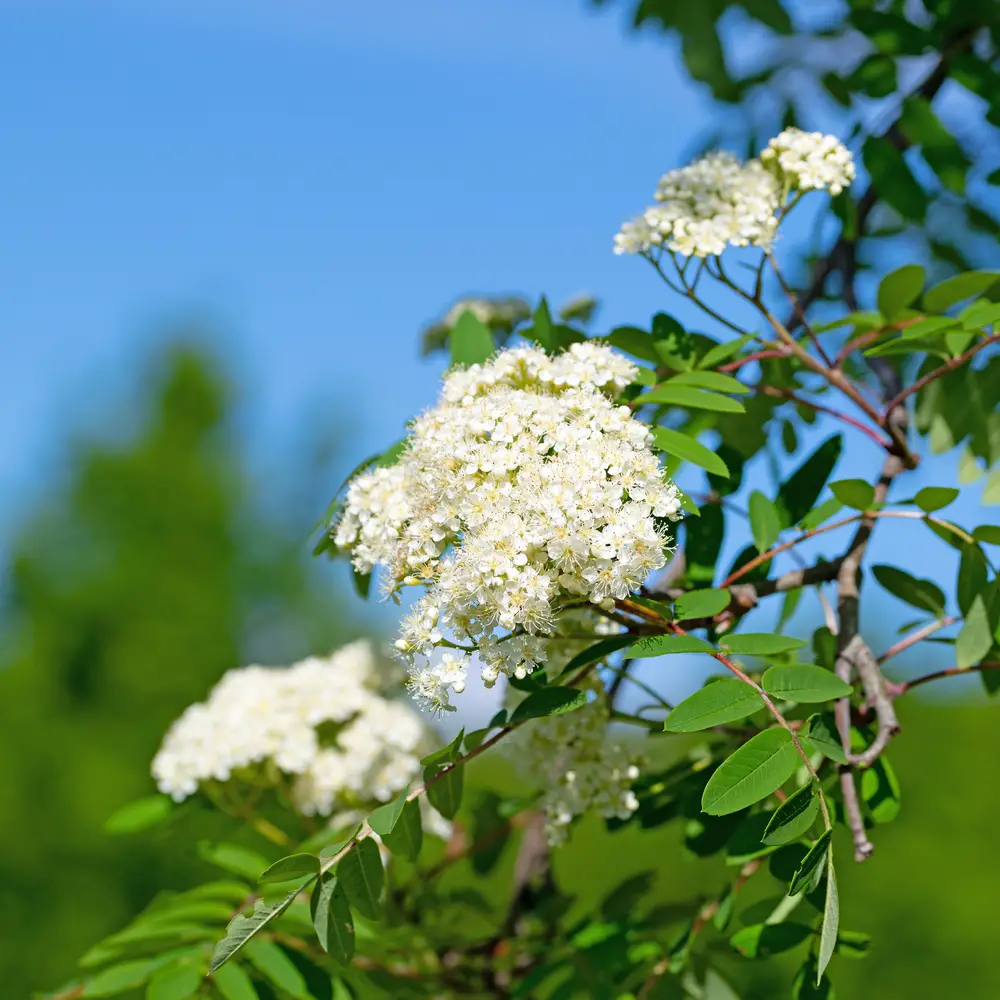
Popular varieties:
- Showy Mountain Ash (Sorbus decora) (USDA zones 3-7)
- European Rowan (Sorbus acuparia) (USDA zones 3-7)
- American Mountain Ash (Sorbus americana) (USDA zones 3-9)
Growing condition requirements: Rowan needs to be planted in rich, well-draining soil and full sun. It will not tolerate drought or overwatering.
Speed of growth: Medium
Size (at maturity): 15 to 30 feet (4.57-9.14 meters) tall and 15 to 20 feet (4.57-6.09 meters) wide
Difficulty for gardener: Easy. Take special care in the first year to ensure trees are receiving adequate water.
Why grow it: Rowan trees provide food for pollinators and birds. They provide seasonal interest all year long with their striking appearance.
Tips, special considerations, and uses: Though they are similar to ash trees, mountain ash trees are not related. Their name is more indicative of their ability to grow at elevation, up to 6,600 feet (2,011.68 meters) above sea level, to be precise.
4 – Japanese Snowbell
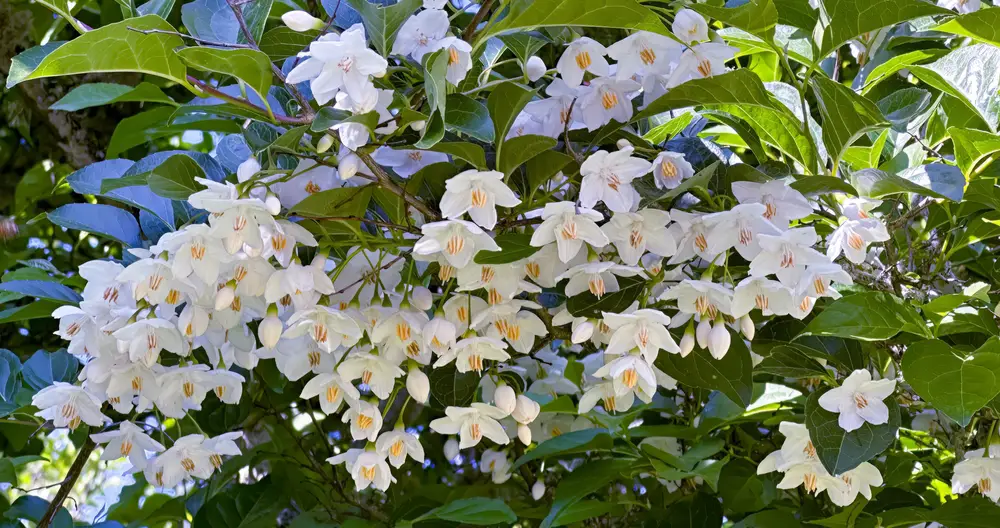
Popular varieties:
- Styrax japonicus ‘Carillon’ (USDA zones 6-8)
- Styrax japonicus ‘Crystal’ (USDA zones 5-8)
- Styrax ‘japonicus’ Issai’ (USDA zones 6-8)
Growing condition requirements: Japanese Snowbell will grow well in a variety of soils but needs good drainage. It will tolerate somewhat dry conditions but not wet ones.
Speed of growth: Slow
Size (at maturity): 20-30 feet tall (6.09-9.14 meters) and 15-25 feet wide (4.57-7.62 meters)
Difficulty for gardener: Easy
Why grow it: Japanese snowbell is a small tree suitable for several urban areas. The tree is a prolific bloomer, and is both beautiful and attractive to pollinators.
It is a low-maintenance, easy-to-grow tree that is gorgeous and fragrant. It typically lives between 50 and 100 years.
Tips, special considerations, and uses: Though it does not grow particularly large, Japanese snowbell wood is very hard. Historically it was used as ribbing in umbrellas and to make toys. The seeds were used to make insecticide. The seed skins contain a soap-like compound and were used to wash clothes.
5 – Apple

Popular varieties:
- Malus pumila ‘Honeycrisp’ (USDA zones 3-7)
- Malus domestica ‘Gala’ (USDA zones 4-8)
- Malus domestica ‘Ambrosia’ (USDA zones 4-8)
Growing condition requirements: Apple trees need full sun (at least 6-8 hours per day). They are pollinated by cross-pollinating, so you need two trees (different are best) to ensure they can produce fruit.
Planting in rich, well-draining soil is best.
Apples can grow from USDA hardiness zones 3-9, but not all apples can grow in all environments. Before planting, check that your apple trees are suited for your area.
Speed of growth: Fast
Size (at maturity): 18-30 feet (5.48-9.14 meters) tall
Difficulty for gardener: Easy
Why grow it: Apple trees are fast-growing and beautiful trees. Plus, if you like eating apples, you can grow some of your favorite varieties right at home. Or, if you are feeling adventurous, you can try growing varieties not available at the grocery store.
Tips, special considerations, and uses: Prune and thin. It can take a few years before your apple trees start to produce fruit.
6 – Fringe Tree

Popular varieties:
- Chionanthus virginicus (USDA zones 4-9)
- Chionanthus retusus ‘Carolina Moonlight’ (USDA zones 5-9)
- Chionanthus retusus ‘Snowdance’ (USDA zones 5-9)
Growing condition requirements: Fringe trees are pretty easy to grow. They need full sun and some protection from strong winds. If you would like them to produce fruit, you need to plant both a male and female.
Speed of growth: Slow
Size (at maturity): 12-20 feet (3.65-6.09 meters) tall and 12-20 feet (3.65-6.09 meters) wide
Difficulty for gardener: Easy
Why grow it: The fringe tree is an unusual beauty and offers interest throughout the seasons. Though its berries aren’t edible to humans, they attract several species of birds and bats.
Fringe trees are small and, even when fully grown, can fit in most gardens.
Tips, special considerations, and uses: Modern herbalists use fringe tree bark to treat liver concerns such as jaundice and gallbladder problems.
7 – Catalpa
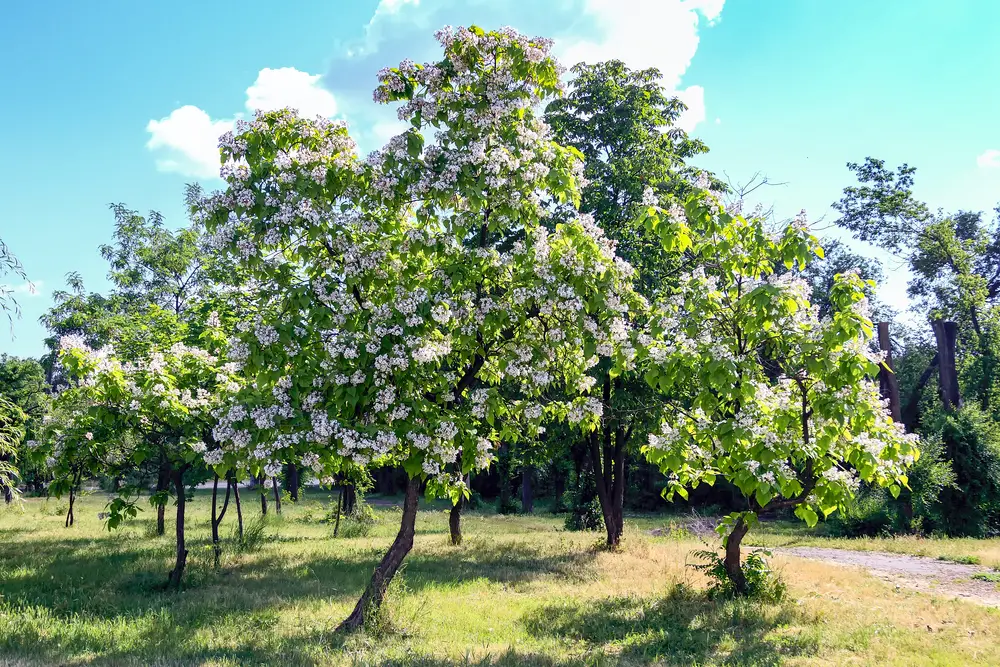
Popular varieties:
- Catalpa speciosa (USDA zones 4-8)
- Catalpa ovata (USDA zones 4-8)
Growing condition requirements: Full sun to partial shade, versatile soil requirements.
Speed of growth: Fast
Size (at maturity): 40-70 feet (12.19-21.33 meters)
Difficulty for gardener: Easy
Why grow it: Catalpa and its large, prolific flowers, add habitat and food for wildlife and pollinators in your yard. Given its size and quick growth, it is used to provide shade.
Tips, special considerations, and uses: Due to its rapid growth, catalpa can stabilize soil that may otherwise be at risk for landslides.
Catalpa is home to the catalpa sphinx moth and its caterpillar is commonly harvested and used by anglers as bait from June throughout the growing season.
8 – Silverbell
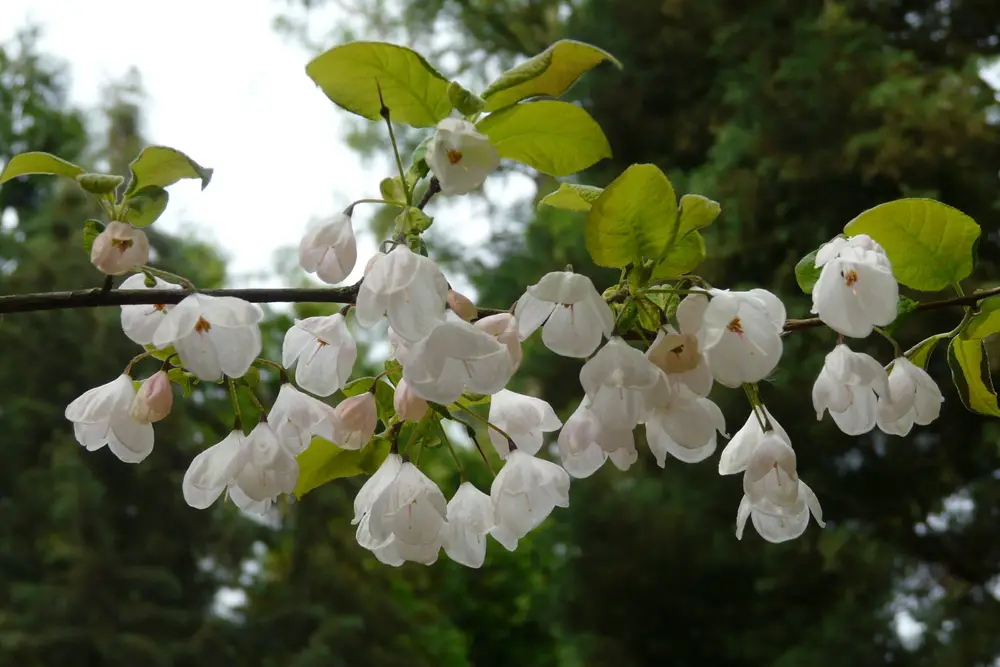
Popular varieties:
- Halesia tetraptera (USDA zones 4-9)
- Halesia carolina (USDA zones 4-8)
Growing condition requirements: Will tolerate full sun but prefers partial shade. It will tolerate wetness. It is sensitive to heat and drought conditions.
Speed of growth: Moderate
Size (at maturity): 30-40 feet (9.144-12.19 meters) tall and 20-35 feet (6.09-10.66 meters) wide.
Difficulty for gardener: Easy
Why grow it: Silverbell trees are quite visually stunning and attract birds and pollinators to gardens where planted.
Tips, special considerations, and uses: Silverbells’ heavy flowering each year makes them very attractive to pollinators, so much so that beekeepers like to include them in their home landscapes. The benefit extends to anyone wanting to support and draw more pollinators into their gardens.
9 – White Oleander
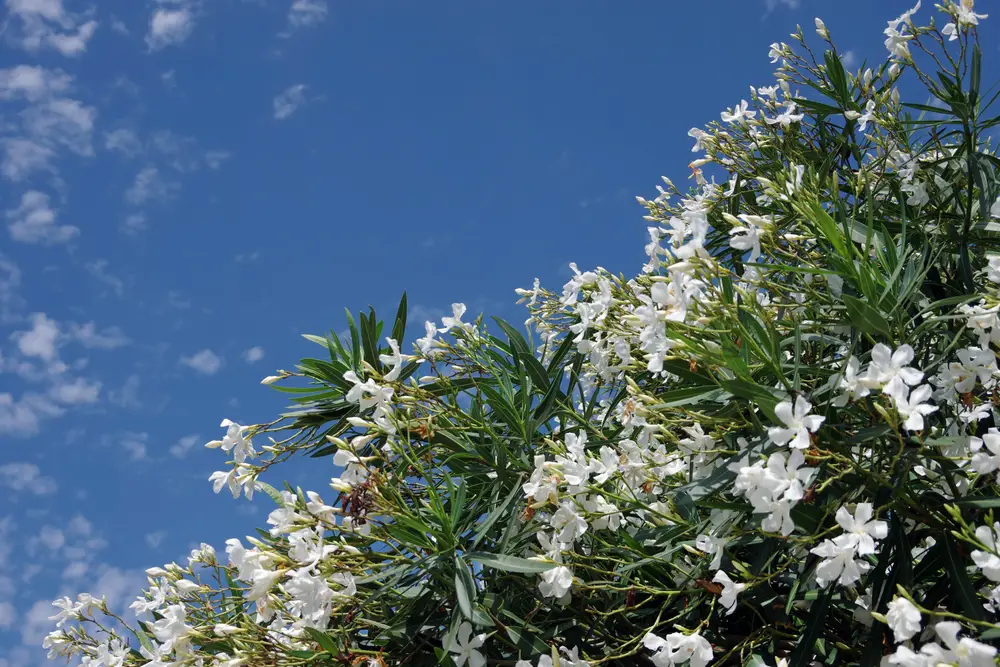
Popular varieties:
- Nerium oleander ‘Album Plenum’ (USDA zones 9-11)
- Nerium oleander ‘Hardy White’ (USDA zones 10-11)
Growing condition requirements: White oleander prefers full sun exposure and can thrive in a wide range of soil conditions. It can tolerate drought and wet conditions for shorter periods but cannot survive sustained frost.
Speed of growth: Moderate to fast
Size (at maturity): 10-20 feet (3.04-6.09 meters) tall and 10-20 feet (3.04-6.09 meters) wide
Difficulty for gardener: Easy
Why grow it: White oleander is decorative and easy to grow in sometimes difficult conditions, such as in seaside gardens where salt is ever-present. It can survive drought and provides useful food for pollinators.
Tips, special considerations, and uses: All parts of oleander are considered toxic for human consumption.
10 – White Crape Myrtle
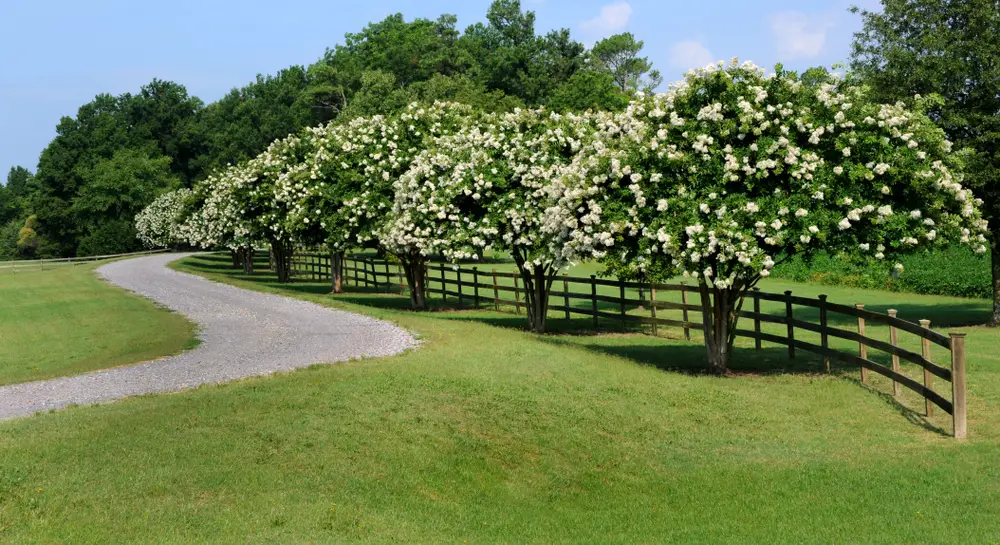
Popular varieties:
- Lagerstroemia indica ‘Natchez White’ (USDA zones 7-9)
- Lagerstroemia indica ‘Fantasy’ (USDA zones 6-9)
- Lagerstroemia indica ‘Acoma’ (USDA zones 6-9)
Growing condition requirements: White crape myrtle prefers full sun and can be planted in a wide variety of soil as long as drainage is sufficient. Though it prefers consistent watering, it can tolerate some drought.
Speed of growth: Fast
Size (at maturity): 20-40 feet (6.09-12.19 meters) tall and 18-25 feet (5.48-7.62 meters)
Difficulty for gardener: Moderate
Why grow it: Crape myrtles are lovely, long-flowering trees that provide habitat and food for wildlife and pollinators. Between its blossoms, beautiful bark, and foliage, it offers visual interest in the garden all year long.
Tips, special considerations, and uses: Exempting the dwarf varieties, crape myrtles can become quite large quite quickly. This makes them useful as shade providers in both home gardens and civic plantings.
Summary
10 trees with white flowers include the following:
- Magnolia trees
- Elder trees
- Rowan trees
- Japanese snowbell trees
- Apple trees
- Fringe trees
- Catalpa trees
- Silverbell trees
- White oleander trees
- White crape myrtle trees
Each has its own care requirements and considerations.
Trees With White Flowers
There is something almost otherworldly about a white flowering tree in full bloom.
No matter who you are or what your level of interest in plants is, such a tree draws your attention and requires a pause to take in its beauty.
If you’re anything like me, your memory is dotted with all manner of plants and places:
- The first time I saw a magnolia in bloom
- The 60-year-old ornamental apple in the backyard of my first house that was, for one day a year, the most beautiful thing in the vicinity
- A spring orchard walk through some blossoming pears at my local cidery
- A visit to the downtown park to see the long-standing cherry blossoms
- The Japanese lilac on the north side of my house that reliably stays in bloom a week longer than the rest
- The bunched sprays of flowers of rowan or elder, buzzing in the sunshine with bees, stunning us now and reminding us of their future fruit, of the shape of things to come
You get the idea and probably have some memories like this yourself.
We mentally catalog these plants, where they live in our cities and neighborhoods, and form relationships with them.
They become touchpoints throughout the year, reminding us where we are in the season. They can be something to look forward to as winter becomes long and things seem kind of dreary.
We seek these plants out again and again, plan to stroll by them or stop for a quiet moment under their canopies each year, timing our visits to hopefully catch them at peak resplendence (it is often quite fleeting), to marvel. They’re just that beautiful.
Whether you’re looking to incorporate this kind of effect into your garden or haven’t considered how striking white blooms can be, here are 10 of my most recommended trees with white flowers.
A Note On Hardiness Zones
Use hardiness zone recommendations as a suggested guideline. If gardeners were to solely follow these recommendations, many of the gardens that exist and thrive wouldn’t be.
If you have your heart set on growing a specific tree or plant that is not recommended for your area according to hardiness recommendations, consider stretching it. Or, consider seeking out someone who already has.
If you’ve looked for locally adapted versions and can’t find them, consider making one yourself.
The only caveat is that these adaptations must be undertaken within reason. Stretching a hardiness recommendation beyond a zone or two is possible, but more than that may not be.
A Note On Common Plant Names
Common plant names vary from place to place.
What I call a mountain ash tree is known in other places as a rowan tree (Sorbus spp.). And it isn’t related to actual ash trees (Fraxinus spp.).
What I call a gooseberry is the fruit of a very thorny woody shrub (Ribes uva-crispa). What someone else calls a gooseberry is a fruit from an herbaceous plant covered in a papery husk (Physalis peruviana).
Undoubtedly, both are gooseberries, but this doesn’t always help us identify plants.
The one never-fail way to definitively communicate about a specific plant with people who may not have the same understanding and experience about plants as you, is to use their scientific, or Latin, name.
1 – Magnolia

Popular varieties:
- Star Magnolia (Magnolia stellata) (USDA zones 4-9)
- Cucumber Tree (Magnolia acuminata) (USDA zones 4-8)
- Sweet Bay Magnolia (Magnolia virginiana) (USDA zones 5-9)
- Southern Magnolia (Magnolia grandiflora) (USDA zones 6-10)
Growing condition requirements: Magnolia thrives in full sun and well-draining, neutral to acidic soil. Plant it somewhere sheltered from intense wind and cold pockets.
Growth speed: Most varieties are slow-growing.
Size (at maturity): Magnolias are big trees. However, there is a large range of sizes and varieties, from 20-80 feet (6.09-24.38 meters) tall to 20-40 feet (6.09-12.19 meters) wide. Choose varieties you appreciate aesthetically but also have room to accommodate. If you are planting a large variety, ensure it is planted well away from your house to avoid any complications from roots.
Difficulty: Magnolias are easy to grow as long as they are planted in the right spot (see growing condition requirements).
Why grow it: One of the oldest known tree species in the world, a magnolia in full bloom is a sight to behold. Many varieties’ flowers also have a lovely fragrance.
Tips, special considerations, and uses: Magnolia roots are shallow and somewhat delicate. When planting, take particular care not to damage roots. When finished planting, the top of the root ball should be at the soil surface.
Keep the magnolia well watered and do not allow the soil to dry out as it establishes itself. Mulching lightly (no more than a layer of 2 inches (5.08 centimeters)) around the base with wood chips or finished compost can help retain water and maintain soil pH and nutrients. Always keep mulch back a few inches from the trunk to avoid rotting.
It may take a couple of years for the tree to bloom. Prune after blooming and sparingly.
Magnolia is a deer-resistant deciduous tree.
All magnolia blooms are edible.
2 – Elder (Sometimes Called Elderberry)

Popular varieties:
- American Elderberry (Sambucus canadensis) (USDA zones 3-9)
- European Elderberry (Sambucus nigra) (USDA zones 3-9)
- Blue Elderberry (Sambucus cerulea) (USDA zones 4-9
Most cultivars are bred from Sambucus canadensis and Sambucus nigra.
Growing condition requirements: Elder isn’t terribly picky and can grow in a wide range of conditions as long as the soil is decent, the sun is plentiful, and moisture is consistent.
Speed of growth: Fast
Size (at maturity): Between 5 and 12 feet (1.5 and 3.65 meters) tall and 10 feet wide (3.04 meters).
Difficulty for gardener: Easy.
Why grow it: Elder is easy to grow and can be a lovely aesthetic addition as well as berry-producing.
Tips, special considerations, and uses: Elder can be grown as a small tree or a sprawling shrub. This will depend on how you prune it.
Elders typically produce berries by the third year. They will produce more when planted within 60 feet (18.28 meters) of another variety.
Berries form on new wood, so if you prune, do so in winter when the plant is dormant. Canes 3 years and older won’t produce many berries, so they are the best to prune out.
The flowers and berries are edible but should only be consumed once ripe, even better if they are also cooked. They are used to make cordials, syrups, jams, and jellies that are enjoyed in cooking and sometimes used medicinally to improve immunity.
3 – Rowan (Also Called Mountain Ash)

Popular varieties:
- Showy Mountain Ash (Sorbus decora) (USDA zones 3-7)
- European Rowan (Sorbus acuparia) (USDA zones 3-7)
- American Mountain Ash (Sorbus americana) (USDA zones 3-9)
Growing condition requirements: Rowan needs to be planted in rich, well-draining soil and full sun. It will not tolerate drought or overwatering.
Speed of growth: Medium
Size (at maturity): 15 to 30 feet (4.57-9.14 meters) tall and 15 to 20 feet (4.57-6.09 meters) wide
Difficulty for gardener: Easy. Take special care in the first year to ensure trees are receiving adequate water.
Why grow it: Rowan trees provide food for pollinators and birds. They provide seasonal interest all year long with their striking appearance.
Tips, special considerations, and uses: Though they are similar to ash trees, mountain ash trees are not related. Their name is more indicative of their ability to grow at elevation, up to 6,600 feet (2,011.68 meters) above sea level, to be precise.
4 – Japanese Snowbell

Popular varieties:
- Styrax japonicus ‘Carillon’ (USDA zones 6-8)
- Styrax japonicus ‘Crystal’ (USDA zones 5-8)
- Styrax ‘japonicus’ Issai’ (USDA zones 6-8)
Growing condition requirements: Japanese Snowbell will grow well in a variety of soils but needs good drainage. It will tolerate somewhat dry conditions but not wet ones.
Speed of growth: Slow
Size (at maturity): 20-30 feet tall (6.09-9.14 meters) and 15-25 feet wide (4.57-7.62 meters)
Difficulty for gardener: Easy
Why grow it: Japanese snowbell is a small tree suitable for several urban areas. The tree is a prolific bloomer, and is both beautiful and attractive to pollinators.
It is a low-maintenance, easy-to-grow tree that is gorgeous and fragrant. It typically lives between 50 and 100 years.
Tips, special considerations, and uses: Though it does not grow particularly large, Japanese snowbell wood is very hard. Historically it was used as ribbing in umbrellas and to make toys. The seeds were used to make insecticide. The seed skins contain a soap-like compound and were used to wash clothes.
5 – Apple

Popular varieties:
- Malus pumila ‘Honeycrisp’ (USDA zones 3-7)
- Malus domestica ‘Gala’ (USDA zones 4-8)
- Malus domestica ‘Ambrosia’ (USDA zones 4-8)
Growing condition requirements: Apple trees need full sun (at least 6-8 hours per day). They are pollinated by cross-pollinating, so you need two trees (different are best) to ensure they can produce fruit.
Planting in rich, well-draining soil is best.
Apples can grow from USDA hardiness zones 3-9, but not all apples can grow in all environments. Before planting, check that your apple trees are suited for your area.
Speed of growth: Fast
Size (at maturity): 18-30 feet (5.48-9.14 meters) tall
Difficulty for gardener: Easy
Why grow it: Apple trees are fast-growing and beautiful trees. Plus, if you like eating apples, you can grow some of your favorite varieties right at home. Or, if you are feeling adventurous, you can try growing varieties not available at the grocery store.
Tips, special considerations, and uses: Prune and thin. It can take a few years before your apple trees start to produce fruit.
6 – Fringe Tree

Popular varieties:
- Chionanthus virginicus (USDA zones 4-9)
- Chionanthus retusus ‘Carolina Moonlight’ (USDA zones 5-9)
- Chionanthus retusus ‘Snowdance’ (USDA zones 5-9)
Growing condition requirements: Fringe trees are pretty easy to grow. They need full sun and some protection from strong winds. If you would like them to produce fruit, you need to plant both a male and female.
Speed of growth: Slow
Size (at maturity): 12-20 feet (3.65-6.09 meters) tall and 12-20 feet (3.65-6.09 meters) wide
Difficulty for gardener: Easy
Why grow it: The fringe tree is an unusual beauty and offers interest throughout the seasons. Though its berries aren’t edible to humans, they attract several species of birds and bats.
Fringe trees are small and, even when fully grown, can fit in most gardens.
Tips, special considerations, and uses: Modern herbalists use fringe tree bark to treat liver concerns such as jaundice and gallbladder problems.
7 – Catalpa

Popular varieties:
- Catalpa speciosa (USDA zones 4-8)
- Catalpa ovata (USDA zones 4-8)
Growing condition requirements: Full sun to partial shade, versatile soil requirements.
Speed of growth: Fast
Size (at maturity): 40-70 feet (12.19-21.33 meters)
Difficulty for gardener: Easy
Why grow it: Catalpa and its large, prolific flowers, add habitat and food for wildlife and pollinators in your yard. Given its size and quick growth, it is used to provide shade.
Tips, special considerations, and uses: Due to its rapid growth, catalpa can stabilize soil that may otherwise be at risk for landslides.
Catalpa is home to the catalpa sphinx moth and its caterpillar is commonly harvested and used by anglers as bait from June throughout the growing season.
8 – Silverbell

Popular varieties:
- Halesia tetraptera (USDA zones 4-9)
- Halesia carolina (USDA zones 4-8)
Growing condition requirements: Will tolerate full sun but prefers partial shade. It will tolerate wetness. It is sensitive to heat and drought conditions.
Speed of growth: Moderate
Size (at maturity): 30-40 feet (9.144-12.19 meters) tall and 20-35 feet (6.09-10.66 meters) wide.
Difficulty for gardener: Easy
Why grow it: Silverbell trees are quite visually stunning and attract birds and pollinators to gardens where planted.
Tips, special considerations, and uses: Silverbells’ heavy flowering each year makes them very attractive to pollinators, so much so that beekeepers like to include them in their home landscapes. The benefit extends to anyone wanting to support and draw more pollinators into their gardens.
9 – White Oleander

Popular varieties:
- Nerium oleander ‘Album Plenum’ (USDA zones 9-11)
- Nerium oleander ‘Hardy White’ (USDA zones 10-11)
Growing condition requirements: White oleander prefers full sun exposure and can thrive in a wide range of soil conditions. It can tolerate drought and wet conditions for shorter periods but cannot survive sustained frost.
Speed of growth: Moderate to fast
Size (at maturity): 10-20 feet (3.04-6.09 meters) tall and 10-20 feet (3.04-6.09 meters) wide
Difficulty for gardener: Easy
Why grow it: White oleander is decorative and easy to grow in sometimes difficult conditions, such as in seaside gardens where salt is ever-present. It can survive drought and provides useful food for pollinators.
Tips, special considerations, and uses: All parts of oleander are considered toxic for human consumption.
10 – White Crape Myrtle

Popular varieties:
- Lagerstroemia indica ‘Natchez White’ (USDA zones 7-9)
- Lagerstroemia indica ‘Fantasy’ (USDA zones 6-9)
- Lagerstroemia indica ‘Acoma’ (USDA zones 6-9)
Growing condition requirements: White crape myrtle prefers full sun and can be planted in a wide variety of soil as long as drainage is sufficient. Though it prefers consistent watering, it can tolerate some drought.
Speed of growth: Fast
Size (at maturity): 20-40 feet (6.09-12.19 meters) tall and 18-25 feet (5.48-7.62 meters)
Difficulty for gardener: Moderate
Why grow it: Crape myrtles are lovely, long-flowering trees that provide habitat and food for wildlife and pollinators. Between its blossoms, beautiful bark, and foliage, it offers visual interest in the garden all year long.
Tips, special considerations, and uses: Exempting the dwarf varieties, crape myrtles can become quite large quite quickly. This makes them useful as shade providers in both home gardens and civic plantings.


